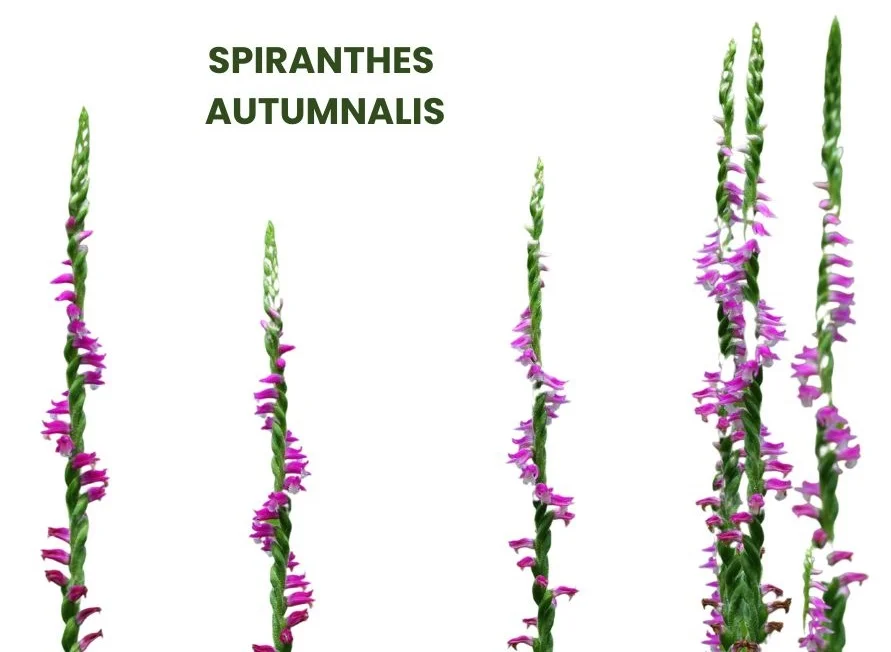Spiranthes autumnalis, commonly known as Lady’s Tresses, is a plant used in homeopathy for its therapeutic effects on various conditions.
It is notably effective in stimulating milk flow in nursing women and alleviating lumbago (lower back pain), rheumatism, and colic.
The remedy is also known for its anti-inflammatory properties, which make it useful for conditions characterized by congestion and inflammation.
It helps with acidity and burning in the esophagus and offers relief for certain gynecological and musculoskeletal issues.

SOURCE INFORMATION
Scientific Classification
- Kingdom: Plantae
- Clade: Angiosperms
- Clade: Monocots
- Order: Asparagales
- Family: Orchidaceae
- Genus: Spiranthes
- Species: Spiranthes autumnalis
Origin and Historical Facts
- Spiranthes autumnalis is native to Europe, North Africa, and parts of Asia.
- The plant thrives in meadows and open grasslands.
- Historically, it has been used in traditional medicine for its anti-inflammatory and soothing properties.
- In homeopathy, it is recognized for treating conditions related to the reproductive system, joint pain, and digestive issues.
DRUG PATHOGENESIS
- The primary action of Spiranthes autumnalis is its anti-inflammatory effect, particularly in the mucous membranes and joints.
- It helps alleviate conditions associated with inflammation and congestion.
- The remedy also addresses digestive disturbances, such as acidity and burning in the esophagus, and provides relief from symptoms associated with colicky pain, such as drowsiness and spasmodic yawning.
KEY CHARACTERISTICS
- Anti-Inflammatory: Reduces inflammation in various body systems.
- Milk Production: Stimulates milk flow in nursing women.
- Musculoskeletal Pain: Effective for back pain, sciatica, and joint issues.
- Gynecological Relief: Addresses vaginal dryness, itching, and bloody leucorrhea.
- Digestive Relief: Alleviates acidity and burning sensations in the esophagus.
DETAILED ORGAN SYMPTOMS
FEMALE REPRODUCTIVE SYSTEM
- Pruritus and Redness: Itching and redness of the vulva.
- Vaginal Dryness and Burning: Sensation of dryness and burning, particularly during intercourse.
- Leucorrhoea: Presence of bloody discharge from the vagina.
MUSCULOSKELETAL SYSTEM
- Lumbago and Rheumatism: Pain in the lower back and joint pain, often accompanied by swelling of veins in the hands.
- Sciatica: Pain extending from the lower back down the right leg.
- Joint Pain: Pain in the shoulders and all articulations of the hands.
- Cold Extremities: Feet and toes feel cold, even when the rest of the body is warm.
DIGESTIVE SYSTEM
- Acidity and Burning: Burning sensation in the esophagus with accompanying eructation (belching).
FEVER
- Heat Flashes: Alternating sensations of heat and cold.
- Sweat: Profuse sweating on the palms, with hands feeling alternately hot and cold.
MODALITIES
- Worse: Symptoms may worsen with cold exposure or damp weather.
- Better: Warmth and rest may provide relief.
WHAT ARE MODALITIES IN HOMOEOPATHY?
RELATIONSHIP WITH OTHER REMEDIES
- Aconite: Shares anti-inflammatory properties and is useful for similar symptoms of congestion and inflammation.
- Bryonia: Compare for joint pain and stiffness that improves with movement.
- Rhus tox: Useful for rheumatic pain that improves with continued movement.
DOSE
- The recommended dosage for Spiranthes autumnalis in homeopathy is the third potency.
- This should be adjusted based on the individual case and the severity of symptoms.
Frequently Asked Questions (FAQs)
What conditions does Spiranthes autumnalis treat?
- It is used for conditions such as lumbago, sciatica, gynecological issues (like vaginal dryness and pruritus), digestive problems (like acidity), and colicky pain.
How does Spiranthes autumnalis compare to Aconite?
- Both remedies have anti-inflammatory effects, but Spiranthes autumnalis is specifically noted for its impact on the reproductive system and digestive tract, while Aconite is more general in its anti-inflammatory and congestion-relieving properties.
What potency is recommended for Spiranthes autumnalis?
- The third potency is commonly recommended, but the dosage can vary depending on the individual’s symptoms and overall condition.
Glossary
- Anti-phlogistic: Reduces inflammation.
- Congestion: Accumulation of fluid or blood in a part of the body.
- Eructation: Belching or burping.
- Leucorrhea: Whitish or yellowish discharge from the vagina.
- Pruritus: Itching sensation.
- Sciatica: Pain along the path of the sciatic nerve, which runs from the lower back through the hips and buttocks and down each leg.
